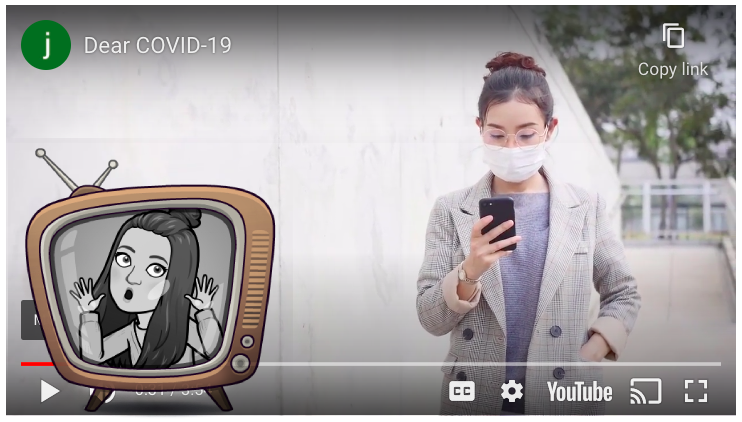 Link to Jasmine’s entry: https://blogs.ubc.ca/2021etec540/2021/02/04/task-4/
Link to Jasmine’s entry: https://blogs.ubc.ca/2021etec540/2021/02/04/task-4/
I was so impressed by Jasmine’s “Dear COVID-19” video letter as a redesign of our “What’s in our bag?” task. She starts off with identifying how different our bags are compared to pre-pandemic. So interesting to see how the pandemic has changed who we are, and by extension our identities if that is indeed what the items in our bags are to represent.
Jasmine’s use of narration and her intentional inclusion of language (French) that reflected her was particularly effective in creating a task that genuinely represented her. In our first task, we just had to take a photo of our items and if we chose to, could include a photo of ourselves. In this redesign, it is undeniable who the owner of this video is. Jasmine seamlessly weaves her written letter with audio and visual mediums. In particular, the selection of the different video clips was done well and it really felt like I was viewing Jasmine’s personal vlog. What made this task more meaningful to Jasmine was that the act of creation itself stirred emotions from her, showing that this was more than just an assignment she had to complete. Genuine reflection can come from tasks that are meaningful and authentic, something that we hope to encourage when teaching with multiliteracies.
Jasmine posits that any time we are taking an available design for our redesign, as per the Pedagogy of Multiliteracies, we are giving existing designs new meaning. This reminds me of the video book trailers that my students created. None of them chose to act (and even the process of acting is still a redesign!) but many chose to snip clips and photoshop images to fit their novels. What struck me their book trailers is how little help they needed from me! They asked each other for help, leaned one each other’s strengths, and created this new trailer on their own all the while being engaged and on-task! While the trailers themselves weren’t cinematic pieces of art, the process of learning and putting it together (and also learning soft skills such as delegation, teamwork, flexibility, and time management) was far more valuable. It is, as Jasmine quotes from The New London Group (1996), “evidence of the ways in which the active intervention in the world that is Designing has transformed the designer” (p. 76). Multimodalities increase accessibility for everyone and meet learners where they are at, but as well, encourage them to develop literacies they aren’t strong in yet.
One very important piece Jasmine noted was that multiliteracies should cater to everyone, and yet in the websites that offer video clips, diversity could only be found if one were to pay for premium features. This presents a challenge to all of us, as we would like our students to be represented, yet we are limited in what resources we can give them.
Lastly, Jasmine closes off with asking whether we could extract our own meaning and reflection from her video. This is another important piece of redesigning: the new meanings created should evoke different feelings and emotions from individuals. If one felt exactly the same was as they did towards the Available Design, one must question whether there was much redesign done at all. This is something important to address, especially with older students who are active in social media and is a part of participatory culture: are their edits, remixes, ‘duets’ on TikTok a redesign, or just a copy? With the availability of media, redesign needs to take into consideration copyright and fair use, topics that are also important to teach alongside multiliteracies when we give our students more opportunities to engage in multimodalities.
References and Related Links
Common Sense Education. (2020, September). Creativity, Copyright, and Fair Use [Video]. YouTube. https://www.youtube.com/watch?v=xvZHNwBHirQ>
Jenkins, H. (2007). Confronting the challenges of participatory culture: Media education for the 21st century – (part one). Nordic Journal of Digital Literacy, 2(1), 23-33.
The New London Group. (1996). A pedagogy of multiliteracies: Designing social futures. Harvard Educational Review 66(1), 60-92.